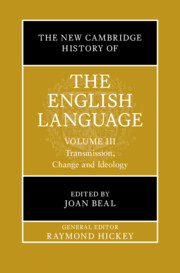Book contents
- The New Cambridge History of the English Language
- The New Cambridge History of the English Language
- The New Cambridge History of the English Language
- Copyright page
- Contents
- Figures
- Tables
- Contributors to Volume III
- General Preface
- Abbreviations
- General Editor’s Introduction
- Introduction to Volume III
- Part I The Transmission of English
- Part II Tracking Change in the History of English
- 6 Spelling Practices and Emergent Standard Writing
- 7 Phonological Change
- 8 Applying Historical Phonology
- 9 The Emerging Phonological Standard
- 10 The History of R in English
- 11 The System of Clausal Complementation
- 12 Tense, Aspect and Modality in the History of English
- 13 Developments in the Passive Construction
- 14 Adverbs in the History of English
- 15 The Story of English Negation
- 16 Dative and Genitive Variability in the History of English
- 17 Relativisation
- 18 Recent Grammatical Change in English
- 19 The History of English Registers
- 20 The History of Semantic Theory
- 21 The Development of Pragmatic Markers
- Part III Ideology, Society and the History of English
- Index
- References
9 - The Emerging Phonological Standard
from Part II - Tracking Change in the History of English
Published online by Cambridge University Press: 23 October 2025
- The New Cambridge History of the English Language
- The New Cambridge History of the English Language
- The New Cambridge History of the English Language
- Copyright page
- Contents
- Figures
- Tables
- Contributors to Volume III
- General Preface
- Abbreviations
- General Editor’s Introduction
- Introduction to Volume III
- Part I The Transmission of English
- Part II Tracking Change in the History of English
- 6 Spelling Practices and Emergent Standard Writing
- 7 Phonological Change
- 8 Applying Historical Phonology
- 9 The Emerging Phonological Standard
- 10 The History of R in English
- 11 The System of Clausal Complementation
- 12 Tense, Aspect and Modality in the History of English
- 13 Developments in the Passive Construction
- 14 Adverbs in the History of English
- 15 The Story of English Negation
- 16 Dative and Genitive Variability in the History of English
- 17 Relativisation
- 18 Recent Grammatical Change in English
- 19 The History of English Registers
- 20 The History of Semantic Theory
- 21 The Development of Pragmatic Markers
- Part III Ideology, Society and the History of English
- Index
- References
Summary
This chapter examines the consolidation of attitudes and praxis in relation to the emergence of a supraregional accent of English. Engaging in detail with phonological history, it documents the increased salience of delocalisation in representations of speech from the mid eighteenth century onwards while exploring the intersection between formal prescription and private practice. An abundance of primary texts on the need for a normative model of speech was in existence by the late nineteenth century while popular culture, and an emerging national system, also addressed desiderata of this kind. The advent of the pronouncing dictionary, an influential sub-genre in the history of lexicography, is a further important strand in the attempted dissemination of one accent for all, though broadcast English brought other avenues by which paradigms of ‘received’ English were both implemented and encouraged. If the social, cultural and linguistic hegemonies of a ‘standard’ accent were originally embedded in formally democratic models, the chapter also provides a critical examination of both the rhetoric and praxis of ‘received’ English in this respect, alongside its legacies in Present-Day English.
Keywords
Information
- Type
- Chapter
- Information
- The New Cambridge History of the English LanguageTransmission, Change and Ideology, pp. 246 - 270Publisher: Cambridge University PressPrint publication year: 2025
References
Accessibility standard: WCAG 2.0 A
Why this information is here
This section outlines the accessibility features of this content - including support for screen readers, full keyboard navigation and high-contrast display options. This may not be relevant for you.Accessibility Information
Content Navigation
Allows you to navigate directly to chapters, sections, or non‐text items through a linked table of contents, reducing the need for extensive scrolling.
Provides an interactive index, letting you go straight to where a term or subject appears in the text without manual searching.
Reading Order & Textual Equivalents
You will encounter all content (including footnotes, captions, etc.) in a clear, sequential flow, making it easier to follow with assistive tools like screen readers.
You get concise descriptions (for images, charts, or media clips), ensuring you do not miss crucial information when visual or audio elements are not accessible.
You get more than just short alt text: you have comprehensive text equivalents, transcripts, captions, or audio descriptions for substantial non‐text content, which is especially helpful for complex visuals or multimedia.
Visual Accessibility
You will still understand key ideas or prompts without relying solely on colour, which is especially helpful if you have colour vision deficiencies.
Structural and Technical Features
You gain clarity from ARIA (Accessible Rich Internet Applications) roles and attributes, as they help assistive technologies interpret how each part of the content functions.
